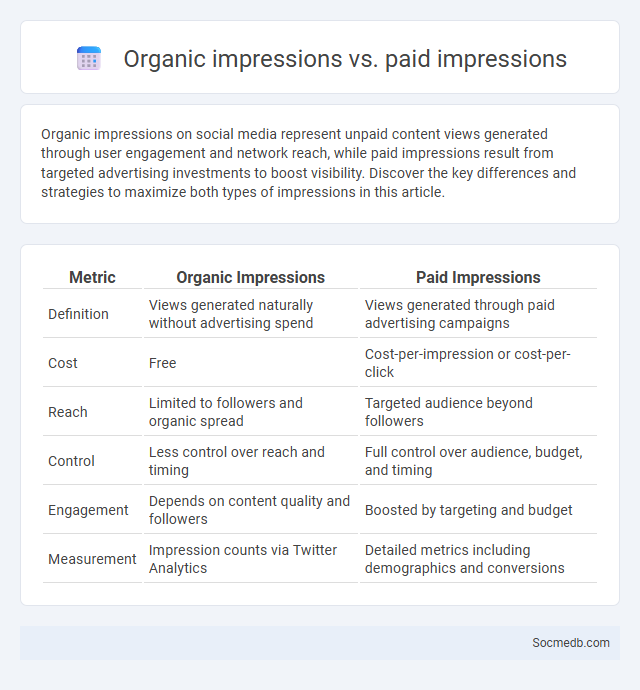
Photo illustration: Organic impressions vs paid impressions
Organic impressions on social media represent unpaid content views generated through user engagement and network reach, while paid impressions result from targeted advertising investments to boost visibility. Discover the key differences and strategies to maximize both types of impressions in this article.
Table of Comparison
| Metric | Organic Impressions | Paid Impressions |
|---|---|---|
| Definition | Views generated naturally without advertising spend | Views generated through paid advertising campaigns |
| Cost | Free | Cost-per-impression or cost-per-click |
| Reach | Limited to followers and organic spread | Targeted audience beyond followers |
| Control | Less control over reach and timing | Full control over audience, budget, and timing |
| Engagement | Depends on content quality and followers | Boosted by targeting and budget |
| Measurement | Impression counts via Twitter Analytics | Detailed metrics including demographics and conversions |
Understanding Organic Impressions
Organic impressions on social media represent the number of times your content is displayed to users without paid promotion, reflecting genuine audience reach and engagement. Monitoring these impressions helps you understand how effectively your posts resonate with your target audience, influencing adjustments to your content strategy. Tracking organic impressions is essential for optimizing your social media presence and maximizing authentic visibility.
Defining Paid Impressions
Paid impressions refer to the total number of times your sponsored content or advertisements are displayed on social media platforms. This metric helps measure the reach and visibility generated through paid campaigns across channels like Facebook, Instagram, Twitter, and LinkedIn. Understanding your paid impressions enables you to optimize ad spend, target specific audiences, and improve the effectiveness of your social media marketing strategy.
The Role of Reports in Digital Marketing
Reports play a crucial role in digital marketing by providing actionable insights through the analysis of social media metrics such as engagement rates, click-through rates, and audience demographics. These data-driven reports enable marketers to optimize campaigns, allocate budgets efficiently, and tailor content strategies to enhance brand visibility and customer interaction. Leveraging platforms like Google Analytics and Facebook Insights enhances the precision of performance tracking, driving informed decision-making and measurable ROI in social media marketing efforts.
Key Differences: Organic vs Paid Impressions
Organic impressions on social media occur when content is viewed without paid promotion, relying on user engagement and platform algorithms to naturally reach audiences. Paid impressions involve targeted ads where advertisers pay to display content to specific demographics, increasing visibility beyond organic reach. The key difference lies in control and scalability; organic impressions depend on content quality and audience behavior, while paid impressions offer precise targeting and immediate exposure.
Measuring Success: Interpreting Impression Reports
Impression reports provide crucial insights into the reach of your social media content by showing how many times posts were displayed to users, helping you gauge audience exposure. Analyzing impressions alongside engagement metrics like clicks and shares offers a clearer picture of content effectiveness and audience interest. You can optimize your strategy by identifying which types of posts generate the highest impressions and adjusting your content accordingly.
Impact on Brand Awareness
Social media significantly enhances brand awareness by enabling businesses to reach vast, targeted audiences through platforms like Facebook, Instagram, and LinkedIn. Engaging content, influencer partnerships, and consistent interactions help your brand gain visibility and build trust with potential customers. Metrics such as reach, impressions, and engagement rates quantify the growth and effectiveness of your social media campaigns.
Cost Analysis: Organic vs Paid Strategies
Social media cost analysis reveals that organic strategies primarily involve time and content creation expenses, whereas paid campaigns require budget allocation for ads and targeting tools. Organic reach tends to be lower but delivers sustained engagement over time without direct financial investment, making it cost-effective for long-term brand building. Paid strategies offer immediate visibility and measurable ROI through precise audience segmentation but demand continuous funding to maintain traffic and conversions.
Optimizing for Maximum Impression Value
Optimizing your social media content for maximum impression value involves targeting high-engagement times and leveraging trending hashtags to increase visibility. Craft visually appealing posts with concise, impactful messaging designed to capture attention quickly across platforms. Regularly analyze performance metrics to refine your strategy and ensure your content consistently reaches the largest relevant audience.
Common Mistakes in Impression Reporting
Common mistakes in impression reporting on social media include double counting impressions across multiple platforms and ignoring the difference between served and viewed impressions, leading to inflated metrics. Overlooking bot traffic and automated views can result in misleading engagement data, skewing campaign performance analysis. Failing to segment impressions by audience demographics or ad placement diminishes the ability to accurately assess targeting effectiveness and return on investment.
Choosing the Right Approach for Your Goals
Selecting the right social media strategy hinges on understanding your target audience, platform algorithms, and content formats that resonate with user behavior. Tailoring your approach to specific goals--whether increasing brand awareness, driving website traffic, or boosting engagement--ensures optimal resource allocation and measurable results. You can maximize the impact of campaigns by leveraging analytics tools to continuously refine tactics and align with evolving digital trends.
 socmedb.com
socmedb.com